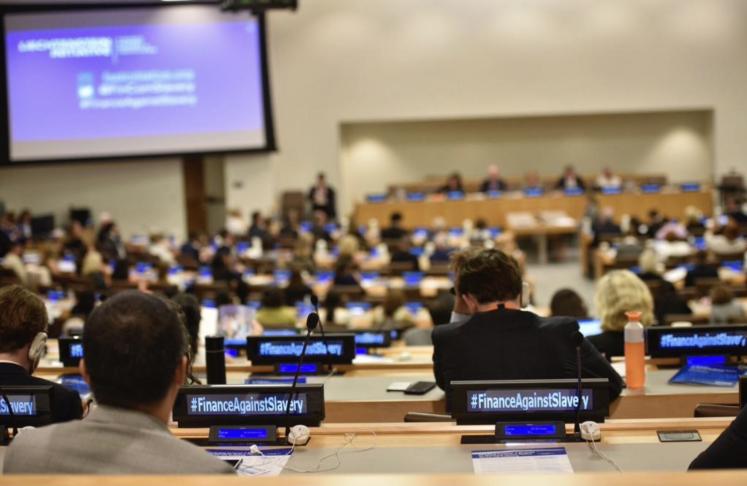The acceleration of digital financial services during COVID-19 presents an opportunity to improve migrant workers’ autonomy and financial health outcomes. On this year’s World Day Against Trafficking in Persons themed: Use and Abuse of Technology, it is fitting to reflect on the Finance Against Slavery and Trafficking (FAST) Blueprint Goal 5: investing in digital finance to help prevent vulnerable populations from exploitation. This blog post will highlight successes and struggles in digital finance aimed at migrant workers—a group particularly susceptible to trafficking and forced labour, and suffered disproportionately during the COVID-19 pandemic.
Migrant workers typically send funds - on average $2-300/month - to their family and friends; remittances that help create livelihood and income opportunities. These remittances, in turn, can protect low-income recipients from exploitation and abuse. At the same time, remittances come at a high cost for migrant workers—many resort to expensive physical exchange houses where the average cost of sending $200 globally is still double the SDG 10 target (three per cent).
Migrant workers often rely on their employer or recruiter for financial access. They may not have the required ID, credit history, or salary level to open bank accounts in the host country or speak the local language. While financial services do not address the root causes of labour exploitation, access and use of appropriate financial services can help build resilience to shocks like the COVID-19 pandemic and decrease migrants' vulnerability to exploitative practices.
While the 2021 Global Findex findings reflect technology's role in increasing access to financial services, such as more first-time users of digital merchant payments in 2021, inclusion in this digital world is not a given. Migrant workers, women (who face a gender gap in account ownership), and rural communities are still being left behind. This could be because of low digital and financial literacy, low-income levels, discriminatory social norms, or simply a lack of products that address customer pain points.
For digital finance to achieve its full potential, providers must design gender-responsive products around customers' unique needs to improve their livelihoods. Providers should also protect customers from fraud, educate them on their choice of financial services and fees, and improve these products based on customer feedback.
Digital Finance Focusing on Generic Products
Over the years, digital finance providers have successfully addressed money transfer, payments, and airtime top-up pain points. However, the United Nations Capital Development Fund (UNCDF) analysis of 15 years of the GSMA State of the Industry on Mobile Money data indicates that the growth rates of active customers (for example, accounts used in the last 30 days) and volumes and values of digital transactions of mobile network operators are trending downward. This suggests that providers' generic offerings do not meet their customers’ multifaceted financial needs, and they have not been able to digitally replicate relevant products customers need like digital lending and savings.
And while Fintechs have come in to fill the digital credit gap in emerging markets, evidence indicates it's had some harmful side effects. While ‘thin-file’ borrowers (for example, those without credit history) gain relatively easy access to digital credit, they can experience predatory lending practices such as social shaming tactics, abuse of data, and vague and adverse repayment terms blacklist unaware borrowers on a credit reference bureau. In 2017, 2.7 million people in Kenya were blacklisted, which prompted the Government to crack down on unregulated digital lenders.
Putting Customers at the Heart of Design
Inclusive Fintechs—tech-first companies focused on underserved populations —are leveraging technology to create products that are more appropriate to users' needs, accessible and affordable. They play a significant role in emerging markets and can offer solutions to migrant workers—if consumer protection principles are addressed. Understanding that remittances are not only about transferring money to points A and B but also improving migrant workers’ financial health, Rise, an early-stage Fintech, provides migrants in the Cooperation Council for the Arab States of the Gulf (GCC) with a wealth management platform. This platform builds financial literacy, provides insurance and investment options, and a no-minimum balance and salary bank account. The GCC is particularly prudent to focus on as 90 per cent of the United Arab Emirates (UAE) consists of foreign nationals, mainly low-wage and semi-skilled workers. Saudi Arabia and the UAE are among the top four countries for remittance outflows.
Another fintech operating in the GCC, NOW Money, offers companies to switch from paying employees in cash to a digital payroll solution in its mobile money account. This also helps companies comply with UAE’s Wages Protection System, improving transparency in labour practices. NOW Money’s account offers customers (employees) a holistic product suite: money transfer options with 90 corridors covered, a Visa card, the ability to manage expenses, and education on fraud prevention. They are piloting a mobile money product tailored to female domestic workers—a primarily hidden group that often experiences exploitative labour practices and faces restrictive social norms.
Literally across the Atlantic, Kadmos, offers seafarers and shippers the ability to receive and manage their salaries instantly, wherever they are, along with money transfer options, and a debit card, among other features, addressing specific needs this group has. Majority, focused on migrant workers in the US, provides a bundled suite of banking services, including remittances, to workers who do not have a US Social Security number—often an impediment to obtaining formal financial services.
These examples provide lessons for digital finance providers exploring how to tailor products and services for migrant workers and communities vulnerable to exploitation.
If you’re already doing this, FAST would love to hear from you at fast@unu.edu.
Suggested citation: Khan Maha., "Banking on Technology: The Case for Migrant Workers," UNU-CPR (blog), 2022-07-30, 2022, https://unu.edu/cpr/blog-post/banking-technology-case-migrant-workers.





